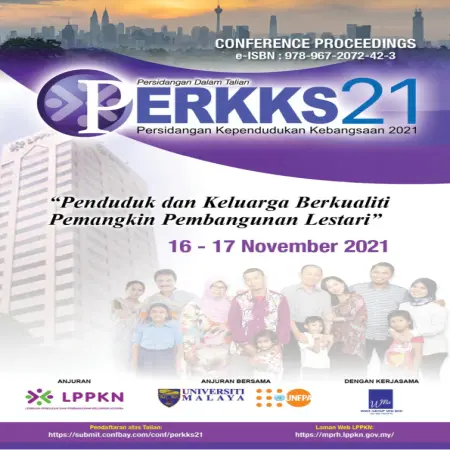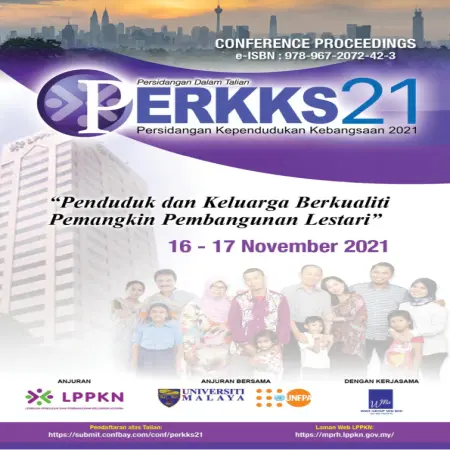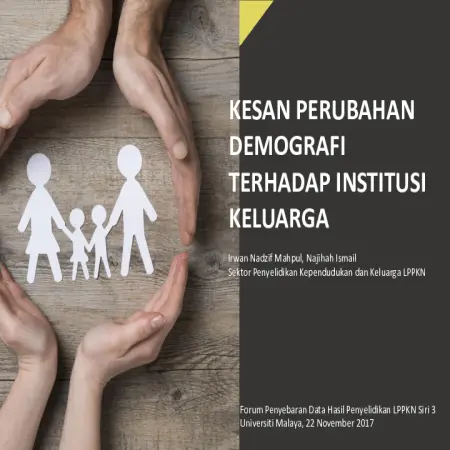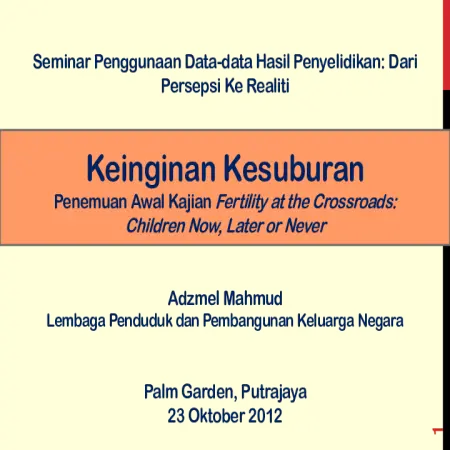Browse by Subject
Results for Search : "305 Social groups"
|
|
Konseptual kualiti hidup dalam konteks golongan pesara di Malaysia
Item Type: Article
Editor:
Year: 00/12/2021
Abstract: Quality of life carries a more complex meaning in explaining the context of an individual's life status, whether they are satisfied and happy with their living conditions or not. The phenomenon of quality of life can be measured by looking at indicators in various aspects whether monetary or non-monetary. This study was conducted to examine what the meaning of quality of life is in the context of retirees in Malaysia. In addition, this study was also conducted to see what indicators affect the quality of life, especially for retirees in Malaysia. In order to achieve the objectives of this study, a qualitative method was used, particularly working on reading sources from previous studies. The sources were screened through Scopus access. The main findings of this study found that there are various indicators that affect the quality of life
retirees in Malaysia and can be divided into two categories, namely monetary which consists of economic indicators, and
residence. While non-monetary consists of indicators of social support, health and family life. Therefore, this study will analyze and conceptually describe the quality of life of the retirees in Malaysia in a more comprehensive way through research on national policies and policies, as well as see a brief comparison with other countries.
|
|
|
|
|
|
Knowledge, attitude and practice on female sexual dysfunction (mati putik) among women in Kuantan, Pahang
Item Type: Article
Editor:
Year: 00/12/2021
Abstract: Female sexual dysfunction or also known as ‘mati putik’ can be defined as women with lack of sexual desire, difficulty in arousal, inability to reach orgasm, pain during intercourse, failure to feel pleasure from sex or anxiety about sex performance. In Malaysia, infidelity or sexual relationship was in the top reasons of divorce cases. Hence, this study aimed to determine the level of knowledge, attitude and practice on female sexual dysfunction among female in Kuantan, Pahang. A total sample of 100 married women was randomly selected based on the classification in inclusive and exclusive criteria.
|
|
|
|
|
|
Kanak-kanak, kemiskinan dan literasi digital: ke arah masa depan digital yang positif
Item Type: Article
Editor:
Year: 00/12/2021
Abstract: Children living in poverty are often denied the experience and ability to use digital media that is beneficial and valuable. Often these children do not have access to digital media and consequently they do not understand the potential of digital technologies. Children from low-income B40 families living in 'Pusat Perumahan Rakyat' (PPR) are a segment of society that may be affected. This study attempts to offer approaches that can help these children by accessing their level of digital media use and digital skills first. A telephone survey of 308 children living in PPR was conducted in March 2021. The study found that children have limited access to digital devices.
|
|
|
|
|
|
Kemiskinan haid: krisis kesihatan awam yang perlu diakhiri
Item Type: Article
Editor:
Year: 00/12/2021
Abstract: Menstrual poverty is a situation when individual face difficulties in obtaining sanitary napkins (pads) or tampons due to financial constraints. It also refers to the lack or absence of sanitation facilities for managing menstruation such as no water supply or no proper waste disposal (sanitary pad) and no privacy to manage menstruation. In addition, lack of knowledge about menstruation and its management is another component of ‘menstrual poverty’. Awareness about ‘menstrual poverty’ needs to be created among the community and other stakeholders such as authorities associated with family and community institutions as well as volunteer organizations. Affected individuals also need to be empowered to speak out about the issues they face. With the pooling of resources and action from all stakeholders, this issue of ‘menstrual poverty’ can be addressed.
|
|
|
|
|
|
Kajian masa depan mengenai matlamat kependudukan 70 juta dan hubungannya dengan pembangunan umat digital di Malaysia
Item Type: Book Section
Editor:
Year: 00/00/2021
Abstract: This paper highlights the discussion of future studies on the population goal of 70 million people and its relationship with the development of the digital community in Malaysia. The total population of Malaysia is still small which is 32.75 million in the first quarter of 2021 with an area of 334,000 square kilometers. The rationale for achieving the population goal of 70 million is to provide a base of demand and market for the products of local industries in addition to receiving many greater benefits and preparing Muslims towards mastering technology.
|
|
|
|
|
|
Keluarga dan cabaran norma baharu
Item Type: Book Section
Editor:
Year: 00/00/2021
Abstract: This paper describes the current situation in family institutions during the pre-pandemic period of Covid-19 by also showing the pattern of family well-being in the country through the Malaysian Family Well-being Index (FWI), a special measurement that has been introduced by the National Population and Family Development Board (NPFDB) since 2011. Although there was an increase in scores in the third series of FWI in 2019, the situation in family institutions seemed to change with the start of the outbreak of the Covid-19 in the country at the beginning of 2020.
|
|
|
|
|
|
Kesan perubahan demografi terhadap institusi keluarga
Item Type: Conference or Workshop Item
Editor:
Year: 00/00/2017
Abstract: Since the 1980s, the fertility rate (TFR) has declined slowly from 4.0 to 2.0 children per woman in 2016. This means that every woman in the country at this point , on average, gives birth to 2 children in her lifetime. The rapid decline in fertility rate (TFR) has accelerated the aging process of the country. The TFR is likely to remain between 1.9 and 2.0 by 2020 and below 1.9 in the next decade. This presentation is about the impact of demographic change on family institutions.
|
|
|
|
|
|
Kajian Penduduk dan Keluarga Malaysia Kelima (KPKM-5)
Item Type: Video
Editor:
Year: 00/00/2014
Abstract: Announcement of the implementation of the Malaysian Population and Family Survey 2014 (MPFS-5).The purpose of this survey was to collect the latest information and time series data in respect of demography, family and reproductive health of the Malaysian population.
|
|
|
|
|
|
Keinginan kesuburan
Item Type: Conference or Workshop Item
Editor:
Year: 00/00/2012
Abstract: The decline in fertility rates in Malaysia is happening rapidly and it is expected that the rate will reach the replacement level (replacement level = 2.1) in 2015. A woman's desire/decision to have a child has a direct impact on the fertility rate and population growth. Thus, the study aims to identify the factors that influence women's desire to have children or do not need to be implemented. Data and Methodology: This paper presents the preliminary findings of the study Fertility at the Crossroad: Children Now, Later or Never conducted by LPPKN in 2012. This study uses a cross -sectional survey design method with a focus on women in the reproductive age group. 15-49 years working in the public sector in Kuala Lumpur, Putrajaya and Selangor. The method of data collection was through face -to -face interviews and self -administered using a questionnaire. Through stratified sampling method, a total of 98 public sector agencies were selected. To achieve the objectives of the study, the data obtained were analyzed using Descriptive Statistics, Chi Square and Logistic Regression (Forward LR Method). The dependent variable studied was the desire to have children (0 = do not want more children, 1 = want more children). While there are nine (9) independent variables studied namely age, ethnicity, education level, job grade (Management and Professional/Support), income, number of childbirths, pregnancy history (miscarriage/stillbirth/abortion), fertility problems and The husband lives far away. Findings: In total, a total of 1,898 data for women working in the public sector were analyzed. A total of 75.9% of respondents have a desire to have children. The results of Chi -Square analysis showed that the variables of age, ethnicity, income, number of births, pregnancy history, fertility problems and husbands living far apart had a significant relationship with the desire to have children. However, there is no evidence to suggest that post grade has a relationship with childbearing desire. Logistic regression test (Forward LR Method) showed that 57.8% of the variation in women's desire to have children can be explained by four independent variables, namely fertility problems, ethnicity, age and number of births. Conclusion: The results of the study found that women's desire to have children can be considered high. To support women's desire to have children, various forms of assistance/support should be provided by the employer/government. Among the main assistance/support needed are childcare centers at work, holiday facilities to care for sick children, subsidized childcare costs and full-paid facilities for children in need of special care.
|
|
|
|













